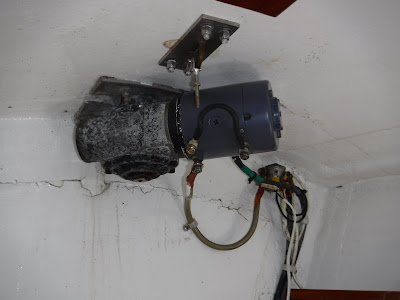Unfortunately I wasn't patient enough because I sheared off the last bolt. I removed the motor housing and saw that because the bolt was soldered to various internal connections the repair job was beyond my competence. Through a local chandlery I contacted someone who I will call MR X, who ran a mobile marine electrical business.
 |
| Windlass at installation in 2008 (Note jumper cable) |
The project became an example of what happens when the tradesman will not listen to the customer and the customer is not assertive enough.
After
repairing the broken connection bolt Mr X fitted the motor case upside
down even though I insisted that was 180 degrees out. He spun the case
around several times and insisted that it would click into position only
his way. What saved the day was that the connection bolts were so
close to the ceiling that he could not fit the nuts, forcing him to have
a really close look and getting it right.
 |
| Mexico 2012 (Note black cable to top of windlass) |
Then
he insisted that the wiring sketch that I provided must be incorrect
because there was no connection post at the top of the case. The
mention of "post" threw me off the scent and I relented because I could
find no post at the top of the case and was puzzled because I NEVER
make mistakes with basic sketches. Mr X got the winch working after two
short circuits resulting in major flashes and one half success where
the winch was going, but backwards. Oh, and he replaced the short
jumper cable that had broken off at one of the connectors with a longer
one that would reach the windlass case, never wondering how the original
shorter cable could have spanned that distance.
My
fundamental mistake was that I expected a marine electrician to know
how to connect a windlass from experience. This man acted as though he
had never seen a windlass before. To avoid having to do some re-typing, here is a slightly edited version of the message that I sent to MR X:
 |
| Wiring by the Expert |
Hello ,
You
will recall that I had misgivings about the connection last Friday of
the Orca VE2000 windlass on my boat Pachuca that you repaired. Yes, I
know that the windlass seemed to be working fine, but I was particularly
concerned about the grounding cable from the motor to the gear housing,
something that I knew was not as before.
I
spent some time locating photos of the windlass to confirm that the
diagram that I had sketched and presented to you was correct.
Have a look the attached photos.
One
photo shows the Orca at installation time in New Zealand in 2008. The
battery cables have not been connected, but you can clearly see the
short jumper cable as sent from the factory.
Another
photo shows the windlass in Mexico in 2012, which I took while painting
the forward section of the boat. You can see the black battery
negative cable passing to the top of the unit.
 |
| Wiring by the Owner |
Also
attached are photos of the cabling as you left it on Friday, to be
compared with the photo as the cabling as I left it yesterday.
The
mystery of the lack of post at the top of the motor case was simple to
solve. I felt along the top of the case and immediately felt a bolt
hole. The bolt that you used to connect the black jumper cable to the
windlass was in fact the bolt for connecting the black negative battery
cable to the top of the motor case.
Why
did the wiring work both ways? I found the wiring diagram for the Orca
VE2000 and working with a friend we concluded that the unit is capable
of lowering as well as raising the anchor. Mine is set up for raising
only. Because of the complex internal wiring it is possible to get the
same result several connection paths.
Having said that, you'll understand why I prefer the connection as before. It looks like the jumper cable connects F1 and F2 (F for "Field"), which are used for raising and lowering the anchor. This was probably done because the windlass was shipped for "raise only" as the default. The red positive battery cable is connected to "A" (for "Armature"). The black positive battery cable is connected to the top of the case.
Having said that, you'll understand why I prefer the connection as before. It looks like the jumper cable connects F1 and F2 (F for "Field"), which are used for raising and lowering the anchor. This was probably done because the windlass was shipped for "raise only" as the default. The red positive battery cable is connected to "A" (for "Armature"). The black positive battery cable is connected to the top of the case.
Regards,
Robert
No comments:
Post a Comment